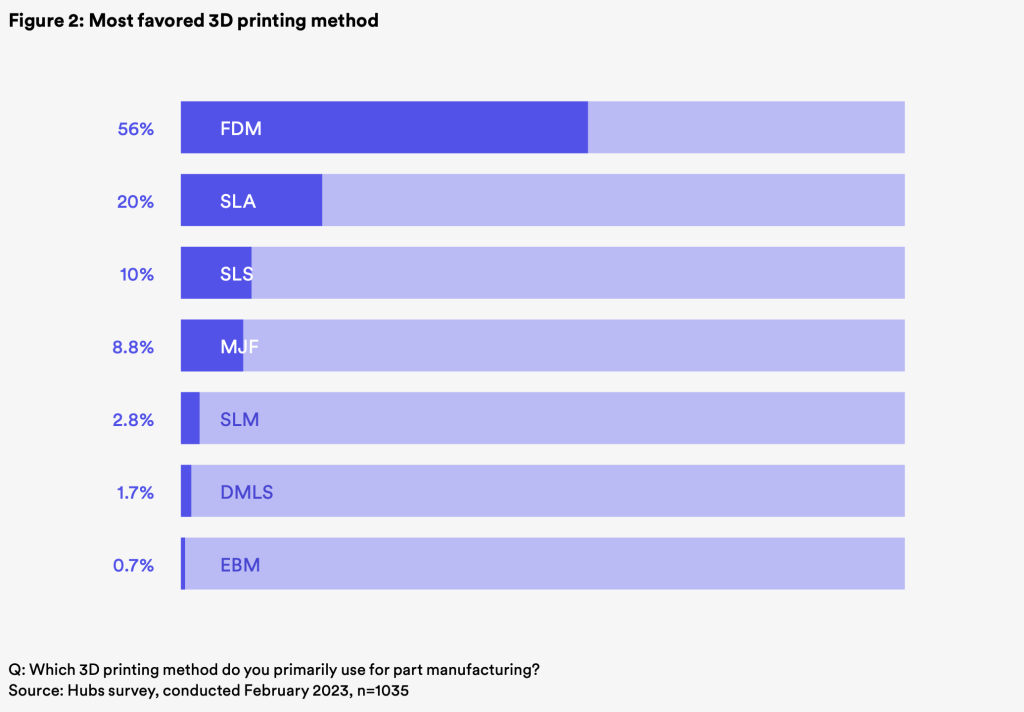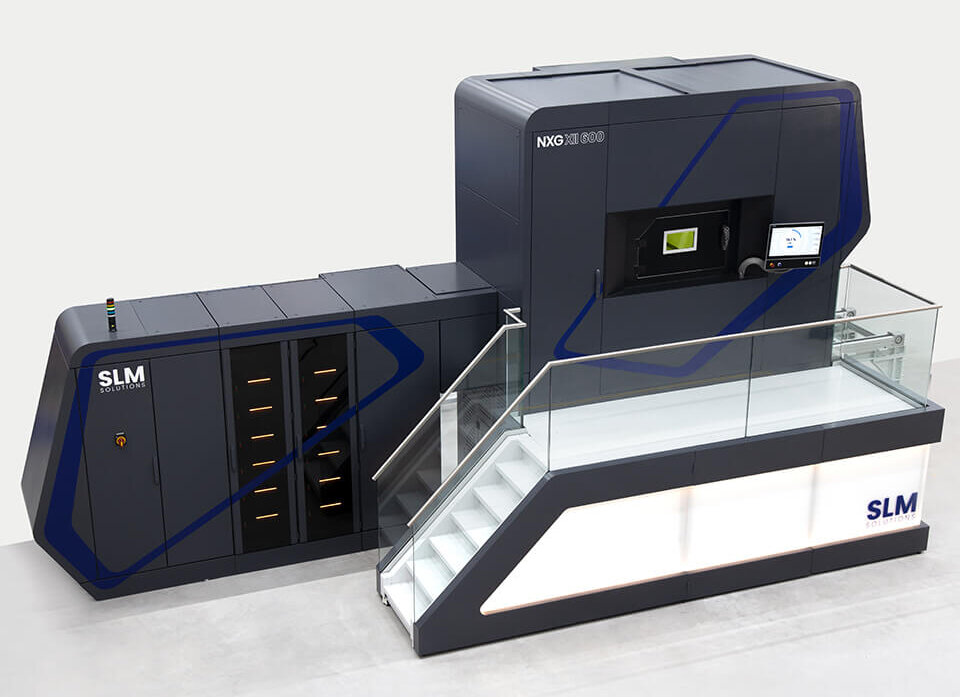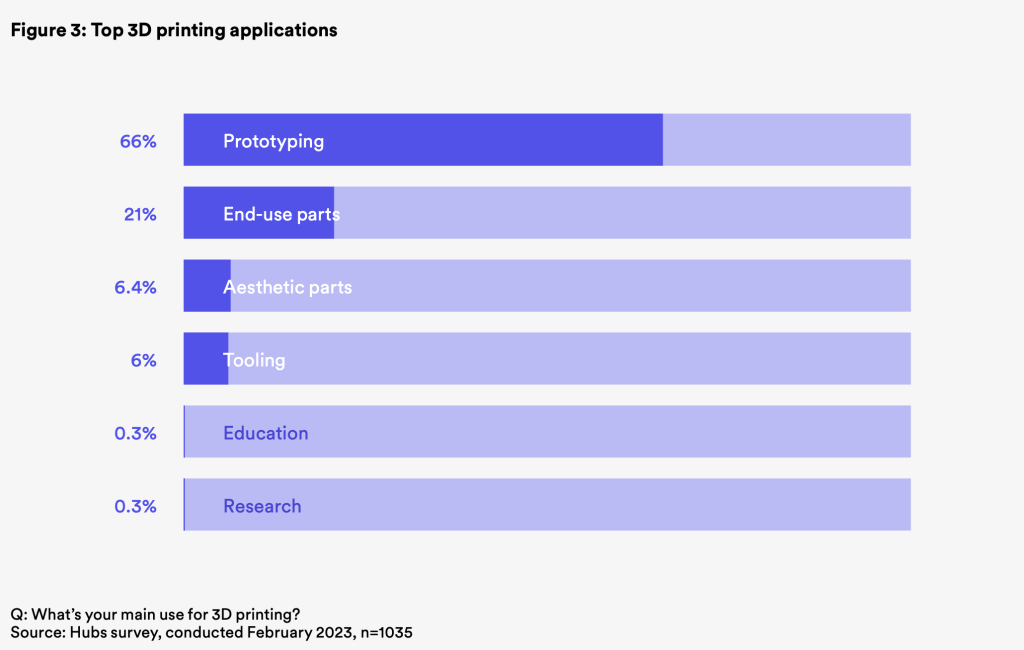Hubs, part of the Protolabs manufacturing network since 2021, has published its 3D printing trend report for 2023.
The headline finding is that 3D printing is “evolving” from a, “hobbyist technology to an industrial manufacturing solution.”
We want to know how to improve 3D printing services. Take the short survey now.
Hubs data shows that 66% of the thousand respondents say prototyping is their main application, while 21% give end-use parts as the primary use of 3D printing. The industry is growing at 17%, according to the report, which uses an average of other reported market growth rates to arrive at this figure. Additionally, Hubs conducted a review of 3D printing news and media.
While metal additive manufacturing is the fastest-growing area, polymer 3D printing generates more than double the revenue. Unsurprisingly FDM remains the most common choice for those included in the survey, with 56% saying it is their most frequently used additive manufacturing method.
For almost half of the respondents to the survey 3D printing now covers up to 20% of their manufacturing requirements, with three-quarters of businesses 3D printing more than ten parts in production runs, a 49% increase from 2021.

Trends in Additive Manufacturing
Earlier this year, 3D Printing Industry released the annual 3D Printing Industry Executive Survey for 2023 on the future of 3D printing. Speaking to experts who provide detailed insights and forecasts, including an expectation of “another dozen million part+ production runs in 2023” from Authentise CEO Andre Wegner.
Among the 3D printing trends identified, 2023 was predicted to be a year of record 3D printer installations as the world returned to business, hastened by the reopening of China and recovery from supply chain disruption. CONTEXT’s Chris Connery pointed out that system revenue growth was likely to be greater than unit shipments, forecasting an increase of 19% for 2023 compared to a unit volume growth of 9%.
3D Systems CEO Jeffrey Graves highlighted the “tremendous uptick in the number of manufacturers that are embracing metal AM for the production of end-use parts,” while Stratasys CTO Guy Menchick noted the “virtuous cycle” of material companies drawn to the growing additive manufacturing sector due to end-use applications.
Recent additive manufacturing technology news
Hubs has also reviewed recent 3D printing news in the report. For example, SLM SolutionsSLM Solutions is developing a version of the laser-powder bed fusion (LPBF) NXG XII 600 system with a 1.5-meter Z-axis for the US Air Force. Billed as the “world’s largest” metal 3D printer, this machine will produce large-scale metal parts using multiple lasers. Caracol’s near-net-shape metal wire arc additive manufacturing (WAAM) system for producing large structures is also mentioned.
Also mentioned is Sculpman, a Belgian startup with variable nozzle technology that can be adjusted to control layer width throughout a build, allowing for faster deposition at high quality.
Hubs also highlights developments in materials and the “ever-growing variety of engineering thermoplastics and resins, composites, polymer powders, and metal powders.” In particular, Electrostatic discharge (ESD) resins, damping elastomer resins, and flame-retardant 3D printing materials have applications in the electronics, wearables, and transport markets.
Software developments, such as GCODE generation software for 3D printing curved lines, gets a mention. Automation with slicer optimization, smart part orientation, batch layouts, and post-processing is highlighted as improving print speed, quality, and consistency. Workflow automation is “vital” for limiting human supervision and lights-out 3D printing. For instance, during CES 2023, Formlabs launched the Automation Ecosystem to reduce idle 3D printer time, improving productivity.

3D printing applications
Prototyping claimed the top spot as the most popular 3D printing application, with 66% of respondents outlining this as their main use for 3D printing. Other key applications include tooling, low-volume production, mass customization, and serial production.
Hubs highlights the key industries using AM as aerospace, medical, and automotive. In 2022 GE Aviation’s Loyang facility in Singapore became the first MRO site to receive approval for using metal Additive Manufacturing to repair commercial jet engine components; the 2022 Cadillac CELESTIQ has 115 3D printed parts. Vat Polymerization accounts for 60% of the dental 3D printing share.

The future of Additive Manufacturing
AI is said to offer “limitless” innovation opportunities within Additive Manufacturing. 3D print monitoring, quality control, generative design, and print optimization may benefit from AI. In medical AI may speed up design for customized prosthetics and medical implants.
Shape morphing systems or 4D printing, may be the future of additive manufacturing. Whilst this technology is still in its infancy, Hubs says, “it’s easy to envision the huge impact it could have on various sectors.”
According to this report, sustainability remains a key benefit of 3D printing. Less waste, localized production, recycling, optimized parts, extending end-of-life, and circular economy, are with green initiatives.
Ultimately, Hubs is confident that 3D printing will continue to grow as a full-fledged manufacturing method. Whilst 20.72% of survey respondents currently use 3D printing to produce end-use parts, continued developments in efficiency, speed, and accessibility will see this number rise in the future.
We want to know how to improve 3D printing services. Take the short survey now.
Subscribe to the 3D Printing Industry newsletter to ensure you keep up with the latest 3D printing news. You can also follow us on Twitter, like our Facebook page, and subscribe to the 3D Printing Industry Youtube channel to access more exclusive content.
Are you interested in working in the additive manufacturing industry? Visit 3D Printing Jobs to view a selection of available roles and kickstart your career.
Featured image shows Hubs’ 3D printing facility in Chicago. Photo via Hubs.


